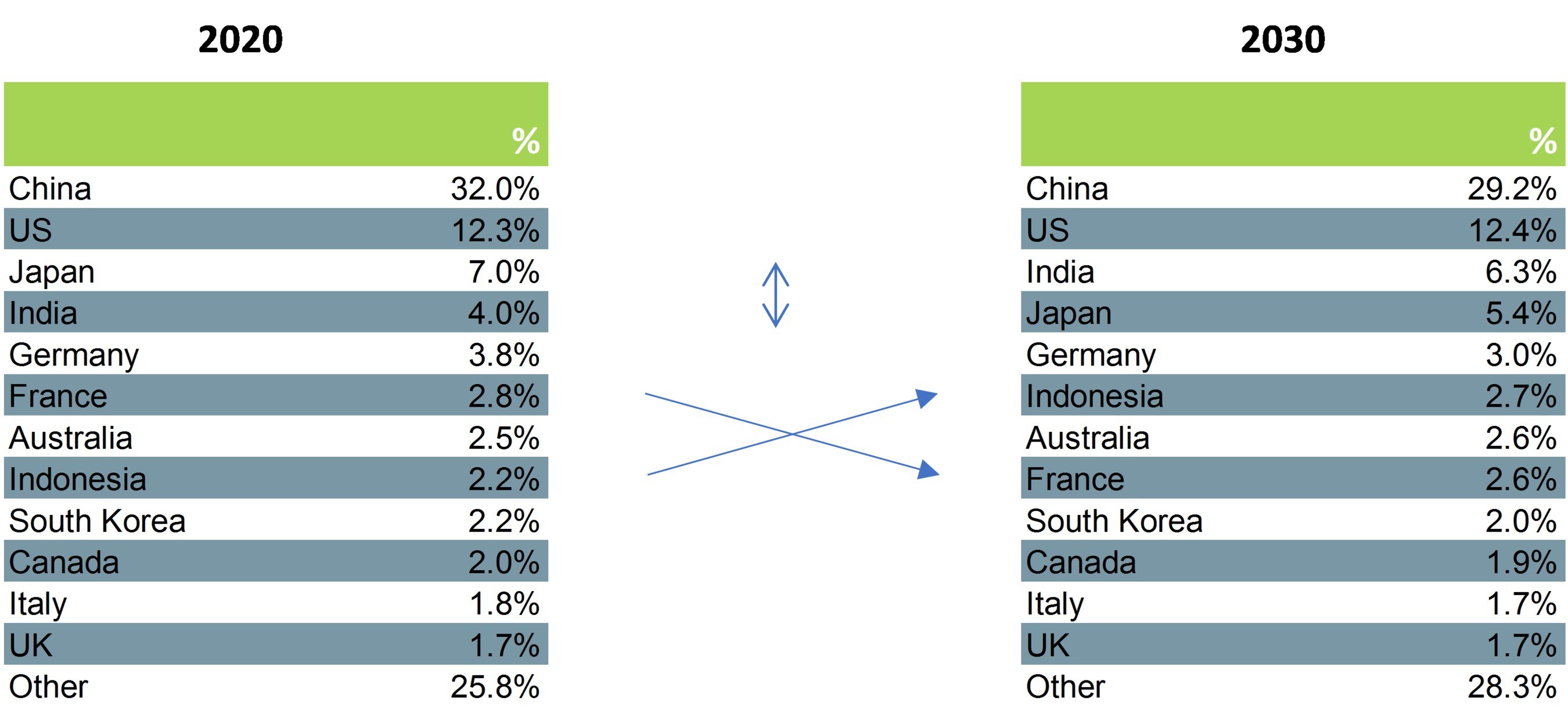Global construction market projections from 2020 to 2030
Contents |
[edit] Introduction
For the construction industry, 2020 was a better year than for many other industries according to the Global Construction 2030 report, published in January 2021.
[edit] Activity in 2020
The volume of global construction output declined by only around 2% in 2020, less than half the rate of decline in the world economy. Construction was categorised as an essential industry in most countries, enabling it to continue working during lockdowns. Also, "work at home" orders encouraged people to invest more in improvements to their own houses.
However, amongst the 90 countries included in the report, 16 had a double-digit percentage decline in their construction volumes in 2020; with Panama (-30%), Singapore (-25%) and the Philippines (-22%) suffering the most significant downturns. Only Saudi Arabia (+15%) had a double-digit percentage increase.
[edit] Future projections
Construction is likely to underperform the global economy in future years, particularly as it experiences the consequences of stretched public finances. This comes despite many countries announcing plans to increase investment in infrastructure.
As the world recovers from COVID, construction volumes are expected to increase globally by an average of 3.2% a year. Double-digit percentage increases are expected in seven countries and declines are anticipated in three countries (all of which are in Europe).
Over the longer term (2023 to 2030), the volume of construction output is projected to increase by an average of 2.3% a year globally, with annual growth rates varying between a decline in Japan (-0.5% p.a.) to increases exceeding 8% a year in Tanzania (+8.4% p.a.), Ethiopia (+8.4% p.a.) and Bangladesh (+8% p.a.).
It is estimated that the value of global construction output in US dollars (at constant exchange rates and in 2020 prices) will increase from $11.6 trillion in 2020 to around $14.8 trillion in 2030.
[edit] Rise and fall
China is expected to remain the largest construction market globally, but to decline in importance from 32% of the global total in 2020 to 29.2% in 2030. Japan's contribution to the total is anticipated to decline from 7% in 2020 to 5.4% in 2030. At this point, India is expected to overtake Japan to become the third largest construction market globally.
Indonesia could surpass France and Australia to become the sixth largest construction market in 2030. France could drop from the sixth largest market in 2020 to the eighth largest in 2030.
| Change in importance of top 12 construction markets between 2020 and 2030 |

|
Around 43 million new homes will be required each year globally between 2020 and 2030, with 11 million of these being in India, 7 million in China, 2 million in Nigeria and 1.5 million in the US. Brazil, Pakistan and Indonesia are also each expected to require more than a million new homes every year.
Separate forecasts have been published for housing, non-housing and infrastructure work for 63 of the 90 countries.
[edit] Related articles on Designing Buildings Wiki
- Construction.
- Construction 2025.
- Construction industry.
- Construction industry outlook on the upswing.
- Construction market forecast 2015 to 2024.
- Top seven trends that will dominate the future of the construction industry
[edit] External resources
Featured articles and news
One of the most impressive Victorian architects. Book review.
RTPI leader to become new CIOB Chief Executive Officer
Dr Victoria Hills MRTPI, FICE to take over after Caroline Gumble’s departure.
Social and affordable housing, a long term plan for delivery
The “Delivering a Decade of Renewal for Social and Affordable Housing” strategy sets out future path.
A change to adoptive architecture
Effects of global weather warming on architectural detailing, material choice and human interaction.
The proposed publicly owned and backed subsidiary of Homes England, to facilitate new homes.
How big is the problem and what can we do to mitigate the effects?
Overheating guidance and tools for building designers
A number of cool guides to help with the heat.
The UK's Modern Industrial Strategy: A 10 year plan
Previous consultation criticism, current key elements and general support with some persisting reservations.
Building Safety Regulator reforms
New roles, new staff and a new fast track service pave the way for a single construction regulator.
Architectural Technologist CPDs and Communications
CIAT CPD… and how you can do it!
Cooling centres and cool spaces
Managing extreme heat in cities by directing the public to places for heat stress relief and water sources.
Winter gardens: A brief history and warm variations
Extending the season with glass in different forms and terms.
Restoring Great Yarmouth's Winter Gardens
Transforming one of the least sustainable constructions imaginable.
Construction Skills Mission Board launch sector drive
Newly formed government and industry collaboration set strategy for recruiting an additional 100,000 construction workers a year.
New Architects Code comes into effect in September 2025
ARB Architects Code of Conduct and Practice available with ongoing consultation regarding guidance.
Welsh Skills Body (Medr) launches ambitious plan
The new skills body brings together funding and regulation of tertiary education and research for the devolved nation.
Paul Gandy FCIOB announced as next CIOB President
Former Tilbury Douglas CEO takes helm.























